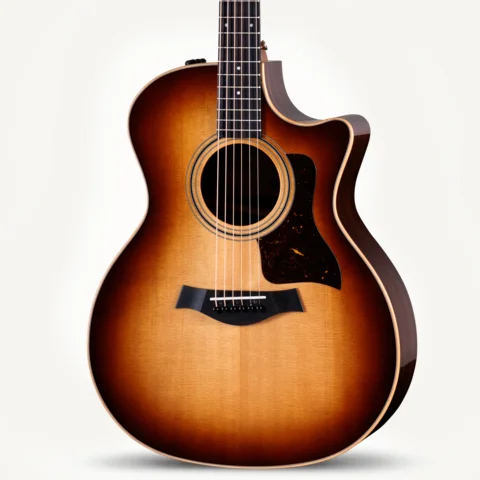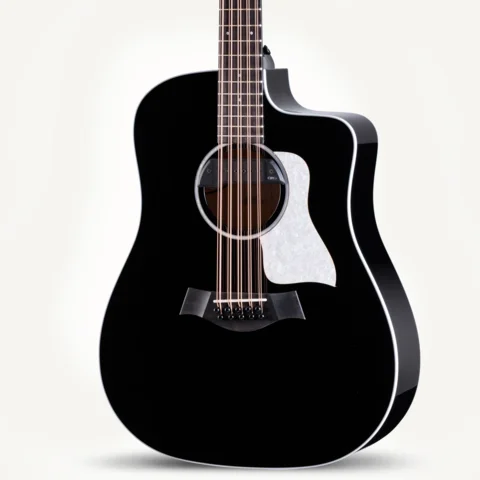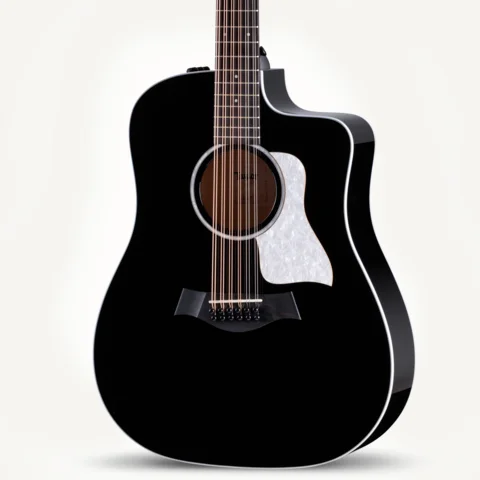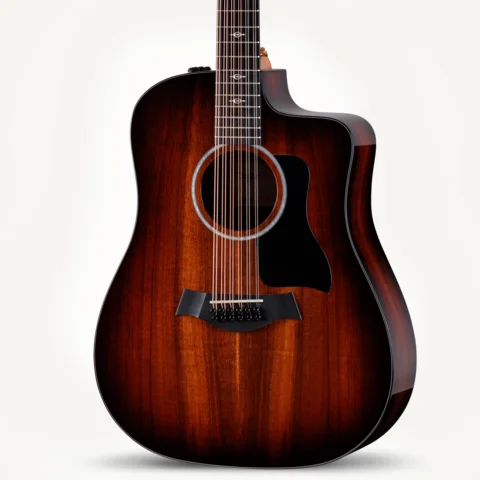A guitar strap is your ticket to full mobility. Whether you’re standing up at the local open mic or running across the stage at Madison Square Garden, a guitar strap gives any guitarist the ability to play your electric or acoustic guitars in any situation.
After the guitar’s body, the strap has the largest point of contact with the guitar player, so installing it correctly is essential for comfortable, ergonomic music-making. We’ve put together this guide to help you attach your guitar strap properly and ensure you’re out there playing in no time.
Putting a Strap On a Guitar with Two Pins
Strap pins (also called strap buttons) are rounded metal posts that protrude from the guitar’s body and tether it to the strap. Electric guitars and basses almost always have two pins, as do many acoustic guitars.
In a two-pin scenario, one strap button will typically be at the bottom end of the guitar. The other one will either be on the top shoulder of the body or behind the neck where it meets the body.
Follow these steps to attach a strap to a guitar with two pins:
- Orient the strap – Some strap styles won’t have a specified top or bottom, but most are designed to attach in a certain way. If your strap has a sliding plastic buckle, orient the end with two overlapping layers of material towards the bottom pin. Similarly, if one end of the strap is thinner than the other, that extremity should be attached at the bottom. Extremities with designs and logos tend to attach to the pin near the neck.
- Attach the strap to the bottom button – Find the thin slit or hole on the end of your strap, and push the strap button through it. You may have to apply some pressure, as the holes are intentionally small to stop the strap from coming off.

- Attach the strap to the top button – Take the other end of the strap, and insert the remaining strap pin through the hole or slit.

- Test it – Tug lightly on each end of the strap to ensure the installation is snug and secure.
Even if your guitar has two strap pins, you may prefer the feeling of the one-pin method below.
Putting a Strap On a Guitar with One Pin
Many acoustic guitars have only one strap pin at the bottom of the instrument. While it’s possible to install a second pin, the standard way to put a strap on a guitar with one button is easy and requires no drilling.
To begin, you’ll follow the first two steps in the section above. Once you’ve secured the strap to the bottom pin, bring the other end up toward the headstock. As you won’t find a guitar strap button up there, you’ll need to secure the strap to the headstock using extra material like a lace or a Strap Adapter. Many straps come with lace for this purpose.
Feed the material through the hole in the strap, then thread one end underneath the strings on the headstock near the nut. Then, if using a lace, tie a tight double knot. With a strap adapter, secure the other end with the supplied pin.
You’ll notice a difference between a strap attached at the headstock and one attached near where the neck meets the body. When the strap is fixed to the headstock, the guitar’s weight should feel balanced toward the center. With two strap buttons, the center of gravity shifts slightly toward the lower bout of the guitar. This difference sways some players with two strap pins to attach their strap to the headstock instead. Feel free to experiment and see what’s best for you.
Adjusting the Strap
Finding the strap length that works for you is another crucial part of setting up your strap. Learning how to adjust your strap on the fly is equally essential.
Strap length largely comes down to personal preference and aesthetics, but there are some ergonomic factors at play. In general, the length of your strap should be such that you never have to fully bend your wrist to reach a note or chord when standing. Relaxing your fret hand and wrist prevents strain and injuries down the road.
Achieving this ideal length is simple. If your strap has a sliding plastic buckle, use this for adjustments. To make the strap longer, slide the buckle towards the lower bout of the guitar; to shorten the strap, slide the buckle towards the neck. You can do this without removing the strap from the guitar.
Leather or suede straps won’t have a plastic buckle. Instead, you’ll notice that most of these straps are two separate pieces. You adjust these straps by removing the smaller piece from the larger one, so this has to be done with the strap detached from the instrument.

The slits in the wide strap piece correspond to different strap lengths. Thread the thin strap piece up through the underside of the strap and pull tight. Then, feed it back through itself by passing through the adjacent slit. Finally, thread it through at least one of the other slits as it makes its way down to the bottom strap button. Try using different slits to find a strap height that works for you.
The Importance of Strap Locks
Once you have your strap at the desired length, consider securing it to your guitar with strap locks. A guitar strap lock protects your guitar from nasty falls by locking the buttons in place.
Our guide on how to use strap locks with an acoustic guitar walks you through the available options for keeping your instrument safe and sound.
Choosing the Right Guitar Strap
Knowing how to put on a guitar strap is only half the battle. With so many materials and styles out there, choosing the right guitar strap for your needs is equally important. Let’s take a look at some of the factors to consider when researching straps.
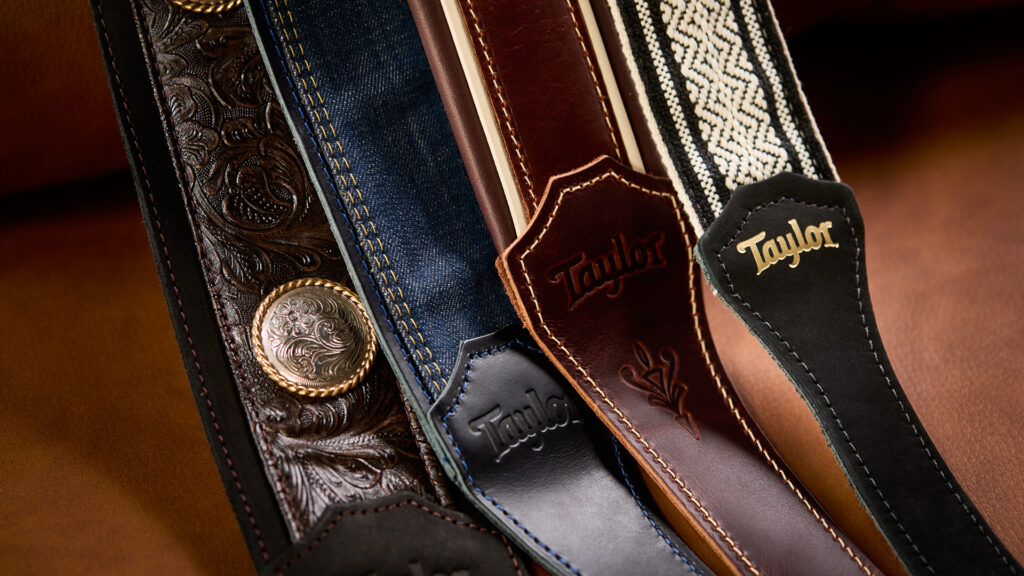
Material
A guitar strap’s material influences its durability, comfort, and price point. Popular strap options include:
- Leather
- Vegan leather
- Suede
- Denim
- Cotton
Regardless of the strap’s primary material, its ends will typically be made of either leather or suede. These ensure a tight fit around the strap buttons.
While there are no limitations to what you can and can’t attach to your guitar, some strap styles have traditional associations with genres or types of guitars. Leather and suede straps have historically gone hand in hand with acoustic guitars, while cotton straps tend to pair nicely with electric guitars, although there are always exceptions.
In terms of cost, the more expensive straps are often the most durable, too. Suede or leather straps are pricier than cotton ones, but they’ll last you a long time. Cotton straps may wear out a little quicker, but they’re affordable, lightweight, and breathable—a perfect stage companion.
Padding
Your typical guitar weighs in at 4-9 pounds. That may not seem like much, but after a four-hour rehearsal, your neck and shoulders might tell you otherwise.
Some guitar straps—especially leather and suede options—come with extra padding for those long sessions. These thin layers of foam or other padding provide added comfort during shows or extended practicing.
Of course, with padding comes the slight extra weight of the strap itself. Though it’ll likely add less than a pound to your setup, it’s still worth noting when shopping for your ideal guitar strap.
Width
A narrower strap will be streamlined and lightweight, but it focuses the load of the guitar on a smaller area of your shoulders. A wider strap distributes the weight of the guitar more evenly and may be the preferred choice for players who stand to play.
The average cotton strap is around 2” wide, while a suede or leather guitar strap can be 2.5” to 3” in width.
Aesthetic
Last, but certainly not least, you probably want a guitar strap that looks as alluring as your guitar. Straps come in every color imaginable and can feature intricate designs, embroidery, nickel conchos—you name it. Whether you lean towards a no-nonsense black cotton strap or a bedazzled leather one, this is your chance to accessorize with your instrument.

For the most striking effect, choose a strap that contrasts with your guitar, like a bold blue denim strap. Or, if you want a more subtle look, find a guitar strap that complements the color and finish of your instrument.
Above all, have some fun with it. Select a strap that speaks to you, install it, and start making music wherever you please.
Time to Play
A guitar strap allows you to play your instrument anywhere and acts as an expression of your personality. A great strap should be comfortable and stylish, which is why we apply the same attention to detail and craftsmanship to our guitar straps as we do our guitars.
Now that you’ve mastered the guitar strap, explore other fundamental skills like how to hold a pick and how to tune your acoustic guitar.






















































